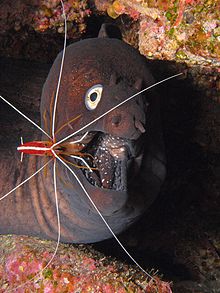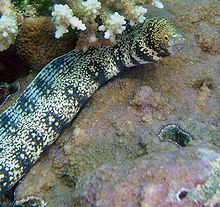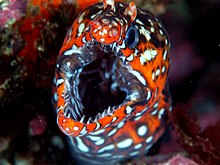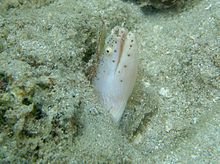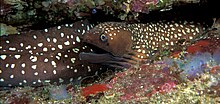Moray eels
| Moray eels | ||||||||||||
|---|---|---|---|---|---|---|---|---|---|---|---|---|

Giant moray ( Gymnothorax javanicus ) in the Red Sea |
||||||||||||
| Systematics | ||||||||||||
|
||||||||||||
| Scientific name | ||||||||||||
| Muraenidae | ||||||||||||
| Rafinesque , 1810 |
Moray eels (Muraenidae) are a family of eel-like bony fish that are distributed in shallow tropical and subtropical seas with around 200 known species. Two species live on the coasts of southern Europe: the Mediterranean moray eel ( Muraena helena ) and the brown moray eel ( Gymnothorax unicolor ). Moray eels are particularly common in the tropical coral reefs : 54 species are counted in the Marianas and the Marshall Islands , in the waters around Hawaii they are the most species-rich family of fish after the wrasse (Labridae) with 32 species .
Since the moray eels lack paired fins and gill covers, they look like snakes . Moray eels are 17 centimeters to four meters long ( Strophidon sathete ).
features
Moray eels are elongated and laterally flattened, the number of vertebrae is usually between 110 and 200, with a maximum of 260. The body is muscular, especially the neck. The color is often brownish or blackish purple, tropical species are often brightly patterned or light. The pectoral and ventral fins have already completely disappeared in the larvae - in contrast to other eels without paired fins, which still have pectoral and ventral fins in the larval stage . The shoulder girdle is reduced to a thin clasp (origin of the pharyngeal muscles).
The skin is flaky and covered by a thick layer of mucus that becomes sticky in the air and protects the animals from injuries when gliding through sharp-edged rocks or corals. A poisonous skin secretion was found in the Indo-Pacific yellow - mouthed moray ( Gymnothorax nudivomer ). The blood of the moray eels - like that of many, perhaps all other eel species - is poisonous due to haemolytic proteins . The poison can be destroyed by heating above 75 ° C. The lateral line organ of the moray eels is reduced to one to three rows of pores on the head and one to two pores in the gill region. In some species, the pores are bordered in white and are easy to see.
The gap in the mouth is deep, extends far behind the eye and is covered with numerous teeth. In addition to the normal teeth on the edge of the jaw, many species also have pointed bone processes in the middle of the upper jaw. (The skull of the other deviates in this region greatly from the teleosts from.) This "pseudo-teeth" are folded closed jaw. The teeth are an important feature in differentiating the genera and species.
The so-called pharyngeal or pharyngeal jaws, which are held only by muscle ligaments, correspond to parts of gill arches and help to pull larger chunks of food towards the stomach, sit in the throat of the morays.

The gill openings are far back on the head and are small and oval. The gill covers are missing; on the other hand, the Branchiostegalradien that span the gill membrane, are numerous and well developed. Moray eels have to pump the water through the gills by regularly opening and closing the mouth - and because the jockstrap is hardly mobile - a behavior that divers often mistakenly regard as "threatening". If the fish are really threatening, they open their mouths wide and stay that way until the danger is over.
Moray eels have four nostrils, two of which are at the tip of the snout, the other two above the front edges of the eyes. The nostrils are connected by a wrinkled system of canals, which gives a large internal surface and gives the fish an excellent sense of smell. On the other hand, they see very poorly. Both the anterior and posterior nostrils can be elongated in a tubular manner. The front then protrude over the tip of the snout, the rear look like horns between the eyes.
The nostrils are also the most certain distinguishing feature from the similar looking snake eels (Ophichthidae), which also often lack the pectoral fins. All four nostrils of the snake eels are located at the tip of the snout, two of them end in downwardly curved tubes.
Way of life
All moray eels live more or less hidden in caves, crevices and coral reefs and only leave their hiding place at night to hunt. You swim with the help of meandering movements of your whole body. During the day, usually only the head protrudes from the shelter. Moray eels are faithful to their location and keep looking for the same hiding place. Larger moray eels also have several shelters that can be up to 200 meters apart. Cave systems can be inhabited by single or multiple moray eels, sometimes of different species. Moray eels often live permanently with cleaner wrasse or cleaner shrimp . They can be cleaned from these and any food residues located between the teeth can be removed from the mouth that is open for this purpose. The cleaners are not eaten.
The species of the genera Anarchias and Uropterygius , which are all relatively small, almost never leave their hiding place and hunt exclusively in caves and crevices. They are therefore almost never seen and their way of life is largely unknown.
Some moray eel species in Southeast Asia and Northern Australia penetrate brackish water and estuaries, the golden dust moray ( Gymnothorax tile ) and leopard moray ( Gymnothorax polyuranodon ) also penetrate fresh water. The leopard moray has already been found 30 km inland in rivers. However, no moray eel lives permanently in fresh water, reproduction always takes place in the sea.
nutrition

All moray eels are predatory fish and feed exclusively on carnivore . There are no pronounced nutrition specialists. However, depending on whether they have pointed or rounded teeth, the different species feed preferentially on fish and cephalopods or on hard-shelled invertebrates such as crustaceans . Few species eat mussels , snails or sea urchins . Fish eaters are mainly the species of the genera Enchelycore and Muraena and many species of the genus Gymnothorax . Echidna and Gymnomuraena mainly eat hard-shelled animals. The fish hunt mainly at dusk or at night, larger specimens only every second or third night or even less often. Your well-developed sense of smell plays a major role in this. They also eat carrion. With some species of the genera Echidna and Gymnothorax , a special behavior was determined during aquarium observations, which otherwise only occurs in hagfish . To tear off pieces of food from larger dead fish, the extremely agile animals form a knot and pull their head through the resulting knot. This now presses on the prey and forms an abutment when pieces of meat are torn out. The same technique is used to pull prey from narrow crevices. Some species also have a particularly narrow mouth.
Reproduction
Very little is known about the reproduction of moray eels. In some species, such as the ghost moray ( Rhinomuraena quaesita ) and the star- spotted moray ( Echidna nebulosa ), a gender change ( dichogamy ) was found, which is also accompanied by a sexual dimorphism . Courting morays stand up, entwine themselves with their bodies and open their mouths wide. The giant moray ( Gymnothorax javanicus ) lays 200,000 to 300,000 eggs, which after swelling have a diameter of 5 mm.
Tribal history

Fossils of moray eel-like fish are known from the Monte Bolca formation from the middle Eocene of northern Italy. The two genera Dalpiaziella and Paranguilla still have small pectoral fins and are classified in the Paranguillidae family. A close relationship with today's moray eels is uncertain.
Systematics
Moray eels belong to the eel-like family and, together with the two poorer species and largely unknown families, Chlopsidae and Myrocongridae, belong to the suborder Muraenoidei. All members of this subordination lack the scales, the lateral line organ and the gill arches are reduced and the frontal bone is divided. The moray eels are divided into two subfamilies, 16 genera and around 200 species.
Subfamily Muraeninae




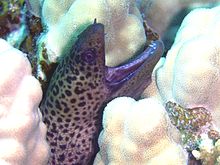


The gill arch sections are not ossified. The fin edge of the dorsal, caudal and anal fin is clearly pronounced.
- Genus Cirrimaxilla
- Cirrimaxilla formosa Chen & Shao, 1995
- Genus Diaphenchelys
- Diaphenchelys dalmatian Hibino et al., 2017
- Diaphenchelys pelonates McCosker & Randall, 2007
- Genus Echidna
- Echidna amblyodon (Bleeker, 1856)
- Chain moray ( Echidna catenata ) (Bloch, 1795)
- Labyrinth moray ( Echidna delicatula ) ( Kaup , 1856)
- Echidna leucotaenia Schultz, 1943
- Star spotted moray ( Echidna nebulosa ) (Ahl, 1789)
- Echidna nocturna (Cope, 1872)
- Echidna peli (Kaup, 1856)
- Ringelmuräne ( Echidna polyzona ) (Richardson, 1845),
- Echidna rhodochilus Bleeker, 1863
- Echidna unicolor Schultz, 1953
- Echidna xanthospilos (Bleeker, 1859)
- Genus Enchelycore
- Tiger moray ( Enchelycore anatina ) (Lowe, 1838)
- Enchelycore bayeri (Schultz, 1953)
- Enchelycore bikiniensis (Schultz, 1953)
- Enchelycore carychroa Böhlke & Böhlke, 1976
- Enchelycore kamara Böhlke & Böhlke, 1980
- Enchelycore lichenosa (Jordan & Snyder, 1901)
- Enchelycore nigricans (Bonnaterre, 1788)
- Enchelycore nycturanus Smith, 2002
- Lesser pine moray ( Enchelycore octaviana ) (Myers & Wade, 1941)
- Dragon moray ( Enchelycore pardalis ) (Temminck & Schlegel, 1846)
- Enchelycore propinqua Mohapatra et al., 2017
- Enchelycore ramosa (Griffin, 1926)
- White- edged moray ( Enchelycore schismatorhynchus ) (Bleeker, 1853)
- Genus Enchelynassa
- Enchelynassa formosa (Quoy & Gaimard, 1824)
- Genus Gymnomuraena
- Zebra moray ( Gymnomuraena zebra ) (Shaw, 1797)
- Genus Gymnothorax
- Gymnothorax afer Bloch , 1795
- Gymnothorax albimarginatus ( Temminck & Schlegel , 1846)
- Gymnothorax angusticauda (Weber & de Beaufort, 1916)
- Gymnothorax angusticeps (Hildebrand & Barton, 1949)
- Gymnothorax annasona (Whitley, 1937)
- Gymnothorax annulatus Smith & Böhlke, 1997
- Gymnothorax atolli (Pietschmann, 1935)
- Gymnothorax australicola Lavenberg, 1992
- Gymnothorax austrinus Böhlke & McCosker, 2001
- Gymnothorax bacalladoi Böhlke & Brito, 1987
- Gymnothorax baranesi Smith, Brokovich & Einbinder, 2008
- Gymnothorax bathyphilus Randall & McCosker, 1975
- Gymnothorax berndti Snyder, 1904
- Bearded moray ( Gymnothorax breedeni ) McCosker & Randall, 1977
- Gymnothorax buroensis ( Bleeker , 1857)
- Chestnut moray ( Gymnothorax castaneus ) ( Jordan & Gilbert, 1883)
- Gymnothorax castlei Böhlke & Randall, 1999
- Gymnothorax cephalospilus Böhlke & McCosker, 2001
- Gymnothorax chilospilus Bleeker, 1865
- Gymnothorax chlamydatus Snyder, 1908
- Gymnothorax conspersus Poey , 1867
- Gymnothorax cribroris Whitley, 1932
- Gymnothorax dorsalis Seale, 1917
- Mottled moray ( Gymnothorax dovii ) ( Günther , 1870)
- Gymnothorax elegans Bliss, 1883
- Gymnothorax enigmaticus McCosker & Randall, 1982
- Gymnothorax equatorialis (Hildebrand, 1946)
- Abbott's moray ( Gymnothorax eurostus ) (Abbott, 1860)
- Gymnothorax eurygnathos Böhlke, 2001
- Net moray ( Gymnothorax favagineus ) Bloch & Schneider , 1801
- Yellow-headed moray ( Gymnothorax fimbriatus ) (Bennett, 1832)
- Yellow-spotted moray ( Gymnothorax flavimarginatus ) ( Rüppell , 1830)
- Gymnothorax flavoculus (Böhlke & Randall, 1996)
- Gymnothorax formosus Bleeker , 1865
- Green Moray Eel ( Gymnothorax funebris ) Ranzani, 1840
- Gymnothorax fuscomaculatus (Schultz, 1953)
- Gymnothorax gracilicauda Jenkins, 1903
- Pointed moray ( Gymnothorax griseus ) ( Lacépède , 1803)
- Gymnothorax hepaticus (Rüppell, 1830)
- Gymnothorax herrei Beebe & Tee-Van, 1933
- Gymnothorax hubbsi Böhlke & Böhlke, 1977
- Gymnothorax indicus Mohapatra et al., 2016
- Gymnothorax intesi (Fourmanoir & Rivaton, 1979)
- Jaguar Moray ( Gymnothorax isingteena ) (Richardson, 1845)
- Giant moray ( Gymnothorax javanicus ) (Bleeker, 1859)
- Gymnothorax johnsoni (Smith, 1962)
- Kidako moray eel ( Gymnothorax kidako ) ( Temminck & Schlegel , 1846)
- Gymnothorax kolpos Böhlke & Böhlke, 1980
- Gymnothorax kontodontos Böhlke, 2000
- Gymnothorax longinquus (Whitley, 1948)
- Gymnothorax maderensis (Johnson, 1862)
- Gymnothorax mareei Poll , 1953
- Gymnothorax margaritophorus Bleeker, 1865
- Gymnothorax marshallensis (Schultz, 1953)
- Gymnothorax mccoskeri Smith & Böhlke, 1997
- Gymnothorax megaspilus Böhlke & Randall, 1995
- Gymnothorax melanosomatus Loh, Shao & Chen, 2011
- Gymnothorax melatremus Schultz, 1953
- Pearl moray ( Gymnothorax meleagris ) ( Shaw , 1795)
- Gymnothorax microspila ( Günther , 1870)
- Gymnothorax microstictus Böhlke, 2000
- Golden-tailed moray ( Gymnothorax miliaris ) ( Kaup , 1856)
- Gymnothorax minor ( Temminck & Schlegel , 1846)
- Gymnothorax mishrai Ray et al., 2015
- Gymnothorax moluccensis ( Bleeker , 1865)
- Gymnothorax monochrous (Bleeker, 1856)
- Gymnothorax monostigma ( Regan , 1909)
- Gymnothorax mordax ( Ayres , 1859)
- Spotted moray ( Gymnothorax moringa ) ( Cuvier , 1829)
- Gymnothorax mucifer Snyder, 1904
- Gymnothorax nasuta de Buen, 1961
- Gymnothorax neglectus Tanaka, 1911
- Gymnothorax nigromarginatus ( Girard , 1858)
- Gymnothorax niphostigmus Chen, Shao & Chen, 1996
- Gymnothorax nubilus ( Richardson , 1848)
- Yellow-mouth moray ( Gymnothorax nudivomer ) (Günther, 1867)
- Gymnothorax nuttingi Snyder, 1904
- Gymnothorax obesus (Whitley, 1932)
- Southern eye-spot moray ( Gymnothorax ocellatus ) Agassiz , 1831
- Gymnothorax panamensis ( Steindachner , 1876)
- Gymnothorax parini Collette, Smith & Böhlke, 1991
- Gymnothorax paucivertebralis Allen et al., 2018
- Gymnothorax phalarus Bussing, 1998
- Gymnothorax phasmatodes (Smith, 1962)
- Gymnothorax philippinus Jordan & Seale, 1907
- Gymnothorax pictus ( Ahl , 1789)
- Gymnothorax pikei Bliss, 1883
- Gymnothorax pindae Smith, 1962
- Gymnothorax polygonius Poey , 1875
- Gymnothorax polyspondylus Böhlke & Randall, 2000
- Leopard moray ( Gymnothorax polyuranodon ) ( Bleeker , 1853)
- Gymnothorax porphyreus (Guichenot, 1848)
- Gymnothorax prasinus (Richardson, 1848)
- Gymnothorax prionodon Ogilby , 1895
- Gymnothorax prismodon Böhlke & Randall, 2000
- Gymnothorax prolatus Sasaki & Amaoka, 1991
- Gymnothorax pseudoherrei Böhlke, 2000
- Gymnothorax pseudomelanosomatus Loh, Shao & Chen, 2015
- Gymnothorax pseudoprolatus Smith et al., 2018
- Gymnothorax pseudothyrsoideus (Bleeker, 1852)
- Gymnothorax pseudotile Mohapatra et al., 2017
- Gymnothorax punctatofasciatus Bleeker, 1863
- Gymnothorax punctatus Bloch & Schneider , 1801
- Gymnothorax randalli Smith & Böhlke, 1997
- Gymnothorax reevesii (Richardson, 1845)
- Gymnothorax reticularis Bloch, 1795
- Richardson moray ( Gymnothorax richardsonii ) (Bleeker, 1852)
- Gymnothorax robinsi Böhlke, 1997
- Yellow- fronted moray ( Gymnothorax rueppellii ) (McClelland, 1844)
- Gymnothorax sagodeta (Richardson, 1848)
- Gymnothorax sagmacephalus Böhlke, 1997
- Gymnothorax saxicola Jordan & Davis, 1891
- Gymnothorax serratidens (Hildebrand & Barton, 1949)
- Gymnothorax smithi Sumod et al., 2019
- Gymnothorax sokotrensis Kotthaus, 1968
- Gymnothorax steindachneri Jordan & Evermann, 1903
- White-eyed moray eel ( Gymnothorax thrysoideus ) (Richardson, 1845)
- Gold dust moray ( Gymnothorax tile ) (Hamilton, 1822)
- Marble moray ( Gymnothorax undulatus ) ( Lacépède )
- Brown moray eel ( Gymnothorax unicolor ) (Delaroche, 1809)
- Gymnothorax vagrans (Seale, 1917)
- Gymnothorax verrilli (Jordan & Gilbert, 1883)
- Gymnothorax vicinus ( Castelnau , 1855)
- Gymnothorax vietnamensis Smith et al., 2018
- Gymnothorax visakhaensis Mohapatra et al., 2017
- Gymnothorax woodwardi McCulloch, 1912
- Gymnothorax ypsilon Hatooka & Randall, 1992
- White-spotted moray ( Gymnothorax zonipectis ) Seale, 1906
- Genus Monopenchelys
- Monopenchelys acuta (Parr, 1930)
- Genus Muraena
- Muraena appendiculata Guichenot, 1848
- Pacific white-spotted moray ( Muraena argus ) ( Steindachner , 1870)
- Muraena augusti
- Muraena australiae Richardson , 1848
- Clock glass moray ( Muraena clepsydra ) Gilbert, 1898
- Mediterranean Moray Eel ( Muraena helena ) Linnaeus , 1758
- Muraena insularum Jordan & Davis, 1891
- Muraena lentiginosa Jenyns, 1842
- Horned moray ( Muraena melanotis ) ( Kaup , 1860)
- Black-eared moray ( Muraena pavonina ) Richardson, 1845
- Atlantic reticulated moray ( Muraena retifera ) Goode & Bean, 1882
- Muraena robusta Osório, 1911
- Genus Pseudechidna
- White ribbon moray ( Pseudechidna brummeri ) (Bleeker, 1859)
- Genus Rhinomuraena
- Eels ( Rhinomuraena quaesita ) Garman, 1888
- Genus Strophidon
- Giant delta moray ( Strophidon sathete ) (Hamilton, 1822)
Subfamily Uropterygiinae
In the first and second gill arch , the lowest of the four gill arch sections is ossified. In addition to the loss of the paired fins, the fin border is also reduced, so that the fish look even more snake-like. Fin rays are only present at the tip of the tail.
- Genus anarchias
- Anarchias allardicei Jordan & Starks, 1906
- Anarchias cantonensis (Schultz, 1943)
- Anarchias euryurus (Lea, 1913)
- Anarchias galapagensis (Seale, 1940)
- Anarchias leucurus (Snyder, 1904)
- Anarchias longicaudis (Peters, 1877)
- Anarchias maldiviensis Klausewitz, 1964
- Seychelles moray ( Anarchias seychellensis ) Smith, 1962
- Anarchias similis (Lea, 1913)
- Genus Channomuraena
- Channomuraena bauchotae Saldanha & Quéro, 1994
- Channomuraena vittata Richardson, 1845
- Genus Scuticaria
- Scuticaria okinawae (Jordan & Snyder, 1901)
- Great tiger moray ( Scuticaria tigrina ) (Lesson, 1828)
- Genus Uropterygius
- Uropterygius alboguttatus Smith, 1962
- Uropterygius concolor Rüppell, 1838
- Uropterygius fasciolatus (Regan, 1909)
- Uropterygius fuscoguttatus Schultz in Schultz, Herald, Lachner, Welander & Woods, 1953
- Uropterygius genie Randall & Golani, 1995
- Uropterygius golanii McCosker & Smith, 1997
- Uropterygius inornatus Gosline, 1958
- Uropterygius kamar McCosker & Randall, 1977
- Needle-tooth moray ( Uropterygius macrocephalus ) (Bleeker, 1865)
- Uropterygius macularius (Lesueur, 1825)
- Uropterygius makatei Gosline, 1958
- Uropterygius marmoratus ( Lacépède , 1803)
- Uropterygius micropterus (Bleeker, 1852)
- Uropterygius nagoensis Hatooka, 1984
- Uropterygius polyspilus (Regan, 1909)
- Uropterygius polystictus Myers & Wade, 1941
- Uropterygius supraforatus (Regan, 1909)
- Uropterygius versutus Bussing, 1991
- Uropterygius wheeleri Blache, 1967
- Uropterygius xanthopterus Bleeker, 1859
- Uropterygius xenodontus McCosker & Smith, 1997
Moray eels and people

In some areas, moray eels are popular food fish. However, the consumption of particularly large species can lead to Ciguatera poisoning , as they accumulate toxins in their meat as the end link in the food chain.
In coral reefs that are heavily frequented by tourists, moray eels are often fed by humans. Moray eels used to feeding change their natural behavior, no longer hunt and can become intrusive towards divers, swim towards them and snap at them. Moray eel bite wounds can be very painful and heal poorly. The bleeding often only stops very slowly. The cause is bacteria on the teeth that get into the wound.
Some particularly colorful morays that inhabit the tropical coral reefs are also caught and imported for aquatic purposes. These are above all the star- spotted moray , the white ribbon moray and the ghost moray . The gold dust moray and the leopard moray are offered by the trade as "freshwater morays", but are better to be kept in brackish or saltwater aquariums . Moray eels are difficult to get used to dead food animals when kept human.
In Conrad Gessner's “Fischbuch” (1558) , the fourth volume of his “Historia animalium”, the moray eel is mentioned in contemporary translations as “Muraal”. It is associated with a species of fish called "Muraal male" ( Latin: Myrus ), although this is a species from the snake eel family ( Echelus myrus ).
Individual evidence
- ^ A b Wilfried Westheide, Reinhard Rieger: Special Zoology Part 2: Vertebrae and Skull Animals , 1st edition, Spectrum Academic Publishing House, Heidelberg, Berlin 2004, ISBN 3-8274-0307-3 .
- ↑ Svein A. Fosså, Alf Jacob Nilsen: coral reef aquarium. Volume 3, Birgit Schmettkamp Verlag, ISBN 3-928819-14-3 .
- ↑ Strophidon sathete on Fishbase.org (English)
- ↑ Marco Lichtenberger: Moränen , in KORALLE, marine aquarium specialist magazine, No. 56 April / May 2009, Natur und Tier Verlag, Münster, ISSN 1439-779X
- ^ Rita Mehta, Peter Wainwright: Raptorial jaws in the throat help moray eels swallow large prey . Nature 449, pp. 79-82 (September 6, 2007) Abstract
- ^ Karl Albert Frickhinger: Fossil Atlas Fish , Mergus-Verlag, Melle, 1999, ISBN 3-88244-018-X .
- ↑ Marco Lichtenberger: Moray eels in the sea water aquarium. Natur und Tier Verlag, 2008, ISBN 978-3-86659-081-6 .
literature
- Joseph S. Nelson : Fishes of the World. John Wiley & Sons, 2006, ISBN 0-471-25031-7 .
- Kurt Fiedler: Textbook of Special Zoology, Volume II, Part 2: Fish. Gustav Fischer Verlag, Jena 1991, ISBN 3-334-00339-6 .
- Rudie H. Kuiter / Helmut Debelius : Atlas of the marine fish. Kosmos-Verlag, 2006, ISBN 3-440-09562-2 .
- Hans A. Baensch / Robert A. Patzner: Mergus Sea Water Atlas Volume 6 Non-Perciformes (non-perch-like). Mergus-Verlag, Melle, ISBN 3-88244-116-X .
- Ewald Lieske / Robert F. Myers: Coral fish of the world. Year publisher, 1994, ISBN 3-86132-112-2 .
- Dieter Eichler / Robert F. Myers: Korallenfische Zentraler Indopazifik , Jahr-Verlag GmbH & Co., 1997, ISBN 3-86132-225-0 .
- Marco Lichtenberger: Moray eels in the seawater aquarium. Natur und Tier Verlag, 2008, ISBN 978-3-86659-081-6 .
Web links
- Moray eels on Fishbase.org (English)
- www.itis.gov: Muraenidae (English)
- www.diveinside.de: Moray eels (PDF file; 892 kB)

